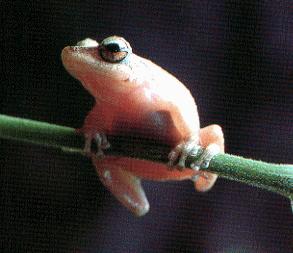Coquíes
Eleutherodactylus coquí
- The Name:
- The name "coquí" is frequently used to describe about 16 different
species of amphibians that fall under the genera Eleutherodactylus in Puerto Rico.
It is also the scientific name of one of these species in particular. (Eleutherodactylus coquí) This last species is also the one
that's most commonly found throughout Puerto Rico.
The name comes from the song that the male of the species is often heard singing in the forest.
What it seems to say is: "cokeé, cokeé". That's why it is called "coquí" in Spanish.
- Description:
- The coquí común varies greatly in coloring and markings. Some have lines or bands that go down the center of their backs. Others have lines on their sides and some of these also have lines going between the eyes. Of course, with such wide variations, it isn't surprising that often people will confuse these frogs as coquies of different species.
- Habitat:
- These frogs are probably most known for their abundance in Puerto Rico.
However,
some Puerto Rican species have also been introduced to other countries. Coquí común lives in some
gardens in Florida, USA. Coquí Churí, has been take to Panamá.
In addition to these man-made introductions of the species into other habitats, there are more than 500 species of Coquí from México to the North of Argentina as well as in the Caribbean islands. In the Greater and Minor Antilles there are over 120 species of Coquí. Only in Puerto Rico is this group of frogs called Coquíes. In other countries they have other names. In Cuba they are called Colines.
- Habits:
-
In the lowlands the coquí is smaller sized and sings quickly. In the highlands, the same type of frog tends to be much larger and sings more slowly. Perhaps the frogs are communicating the changes in temperature(?)
 This picture was sent to me by a Frogland visitor.
This picture was sent to me by a Frogland visitor.
Listen to the Coquí song:
 89KB WAV file
89KB WAV file
Links of interest:
- The Coqui Description at the Welcome to Puerto Rico homepage
- Lovesick frogs of the rainforest
- Alien Frog Species in Hawaii lists the coqui as a species of frog that was unnaturally introduced to Hawaii. Other than the fact that these are pretty noisy frogs and this bugs the locals, there are also some real legitimate concerns that such man-made introductions can disrupt the natural balance of wildlife there.
- HawaiianCoqui.org/ - an alternate viewpoint, that speaks of Hawaiian love for the Coqui. "We are currently conducting a "Kisses for Coquis" Campaign in Puerto Rico, getting people to send chocolate kisses to our governor to help stop the frog war. (Puerto Ricans LOVE the coqui. It's their national animal.)"
This group claims that "the local eradication interests have been whipping up hatred forthe frogs to encourage funding for control efforts. Ironically, the sound
is so loved in Puerto Rico that many people take recordings of the coquis
with them while travelling to help them sleep! And many Hawaii residents
also love the sound."
Back to Species Info Page.
Back to Frequently Asked Questions About Pet Frogs.
Back to FROGLAND.
 This picture was sent to me by a Frogland visitor.
This picture was sent to me by a Frogland visitor.![]() 89KB WAV file
89KB WAV file